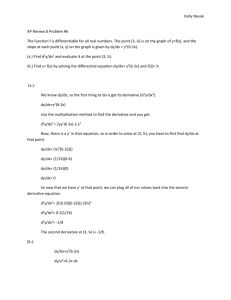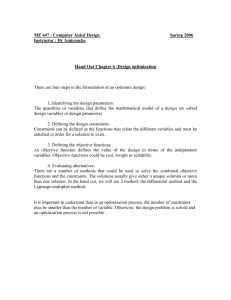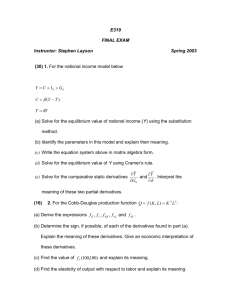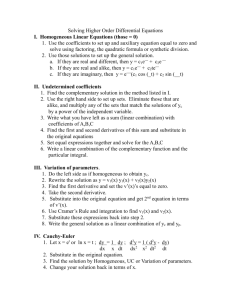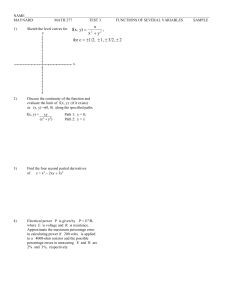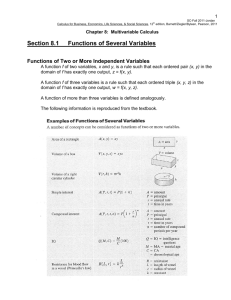Powerpoint slides for Chapter 7.
advertisement
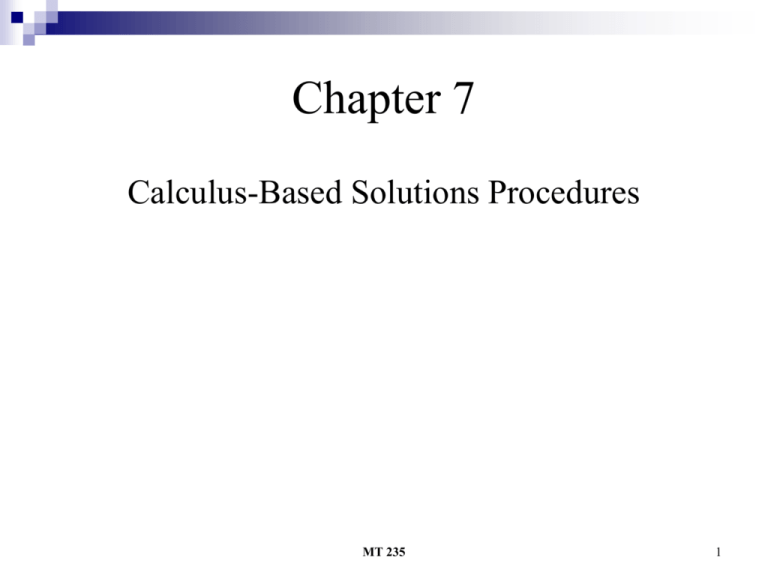
Chapter 7 Calculus-Based Solutions Procedures MT 235 1 Nonlinear Optimization Review of Derivatives Models with One Decision Variable Unconstrained Models with More Than One Decision Variable Models with Equality Constraints: Lagrange Multipliers Interpretation of Lagrange Multiplier Models Involving Inequality Constraints MT 235 2 Review of 1st Derivatives Notation: y = f(x), dy/dx = f’(x) f(x) = c f(x) = xn f(x) = x f(x) = x5 f(x) = 1/x3 f(x) = c*g(x) f(x) = 10*x2 f(x) = u(x)+v(x) f(x) = x2 - 5x f’(x) = 0 f’(x) = n*x(n-1) f’(x) = 1*x0 = 1 f’(x) = 5*x4 f(x) = x-3 f’(x) = -3*x-4 f’(x) = c*g’(x) f’(x) = 20*x f’(x) = u’(x)+v’(x) f’(x) = 2x - 5 MT 235 3 Review of 2nd Derivatives Notation: y = f(x), d(f’(x))/dx = d2y/dx2 = f’’(x) f(x) = -x2 f(x) = x-3 f’(x) = -2x f’(x) = -3x-4 MT 235 f’’(x) = -2 f’’(x) = 12x-5 4 Nonlinear Optimization Review of Derivatives Models with One Decision Variable Unconstrained Models with More Than One Decision Variable Models with Equality Constraints: Lagrange Multipliers Interpretation of Lagrange Multiplier Models Involving Inequality Constraints MT 235 5 Models with One Decision Variable Requires 1st & 2nd derivative tests MT 235 6 1st & 2nd Derivative Tests Rule 1 (Necessary Condition): df/dx =0 Rule 2 (Sufficient Condition): d2f/dx2 >0 d2f/dx2 < 0 Minimum Maximum MT 235 7 Maximum Example Rule 1: = y = -50 + 100x – 5x2 dy/dx = 100 – 10x = 0, x = 10 f(x) Rule 2: d2y/dx2 = -10 Therefore, since d2y/dx2 < 0: f(x) has a Maximum at x=10 MT 235 8 Y = f(x) Maximum Example – Graph Solution 500 450 400 350 300 250 200 150 100 50 0 1 2 3 4 5 6 7 8 9 10 11 12 13 14 15 16 17 18 19 x MT 235 9 Minimum Example Rule 1: = y = x2 – 6x + 9 dy/dx = 2x - 6 = 0, x = 3 f(x) Rule 2: d2y/dx2 =2 Therefore, since d2y/dx2 > 0: f(x) has a Minimum at x=3. MT 235 10 Minimum Example – Graph Solution 400 350 Y = f(x) 300 250 200 150 100 50 0 1 4 7 3 10 13 16 19 22 25 28 31 34 37 x MT 235 11 Max & Min Example Rule 1: = y = x3/3 – x2 dy/dx = f’(x) = x2 – 2x = 0; x = 0, 2 f(x) Rule 2: = f’’(x) = 2x – 2 = 0 2(0) – 2 = -2, f’’(x=0) = -2 d2y/dx2 Therefore, d2y/dx2 < 0: Maximum of f(x) at x=0 2(2) – 2 = 2, f’’(x=2) = 2 Therefore, d2y/dx2 > 0: Minimum of f(x) at x=2 MT 235 12 Max & Min Example – Graph Solution 6 4 Y = f(x) 2 0 -2 2 0 1 4 7 10 13 16 19 22 25 28 31 34 37 -4 -6 -8 x MT 235 13 Example: Cubic Cost Function Resulting in Quadratic 1st Derivative Rule 1: f(x) = C = 10x3 – 200x2 – 30x + 15,000 dC/dx = f’(x)= 30x2 – 400x – 30 = 0 Quadratic Form: ax2 + bx + c x b b^ 2 4ac 2a x 400 (400)^ 2 4(30)( 30) 2(30) x 13.4,.07 MT 235 14 Example: Cubic Cost Function Resulting in Quadratic 1st Derivative Rule 2: = f’’(x) = 60x – 400 60(13.4) – 400 = 404 > 0 d2y/dx2 Therefore, d2y/dx2 > 0: Minimum of f(x) at x = 13.4 60(-.07) – 400 = -404.2 < 0 Therefore, d2y/dx2 < 0: Maximum of f(x) at x = -.07 MT 235 15 Cost $ (C) = f(x) Cubic Cost Function – Graph Solution 50000 45000 40000 35000 30000 25000 20000 15000 10000 5000 0 1 4 -.077 10 13 16 13.4 19 22 25 28 31 34 37 x = Units Produced MT 235 16 Economic Order Quantity – EOQ Assumptions: Demand for a particular item is known and constant Reorder time (time from when the order is placed until the shipment arrives) is also known The order is filled all at once, i.e. when the shipment arrives, it arrives all at once and in the quantity requested Annual cost of carrying the item in inventory is proportional to the value of the items in inventory Ordering cost is fixed and constant, regardless of the size of the order MT 235 17 Economic Order Quantity – EOQ Variable Definitions: Let Q represent the optimal order quantity, or the EOQ Ch represent the annual carrying (or holding) cost per unit of inventory Co represent the fixed ordering costs per order D represent the number of units demanded annually MT 235 18 Economic Order Quantity – EOQ Note: If all the previous assumptions are satisfied, then the number of units in inventory would follow the pattern in the graph below: EOQ Model Q Time MT 235 19 Economic Order Quantity – EOQ At time = 0 after the initial delivery, the inventory level would be Q. The inventory level would then decline, following the straight line since demand is constant. When the inventory just reaches zero, the next delivery would occur (since delivery time is known and constant) and the inventory would instantaneously return to Q. This pattern would repeat throughout the year. MT 235 20 Economic Order Quantity – EOQ Under these assumptions: Average Inventory Level = Q/2 Annual Carrying (or Holding) Cost = (Q/2)*Ch The annual ordering cost would be the number of orders times the ordering cost: (D/Q)* Co Total Annual Cost = TC = (Q/2)*Ch+(D/Q)* Co MT 235 21 Economic Order Quantity – EOQ To find the Optimal Order Quantity, Q take the first derivative of TC with respect to Q: (dTC/dQ) = (Ch/2) – DCoQ-2 = 0 Solving this for Q, we find: Q* = (2DCo/Ch)^(1/2) Which is the Optimal Order Quaintly Checking the second-order conditions (Rule 2 in our text), we have: (d2TC/dQ2)= (2DCo/Q3) Which is always > 0, since all the quantities in the expression are positive. Therefore, Q* gives a minimum value for total cost (TC) MT 235 22 Nation’s Healthcare Inc (NHI) has collected historical data on the cost of operating a large hospital. The operating cost turns out to be a nonlinear function of the number of patient days per year, approximated by the function: C 4,700,00 .00013x 2 where C is the total annual cost and x is the number of patient days per year. a. Write the equation for cost per patient day. b. Find the value of x (patient days) which minimizes cost per patient day. c. Find the minimum cost per patient day. MT 235 23 Orion Outfitters is trying to price a new pair of ski goggles. They have estimates of the relationship between price and the number of units sold as below: p 50 .05 x where p is the price and x is the number of units sold. a. Write the equation for total revenue. b. Find the number of units to sell in order to maximize revenue. c. Find the revenue-maximizing price. d. Find the maximum revenue. MT 235 24 SouthStar Inc. (SSI) produces lawn tractors at a single factory. Based on a number of years of data, SSI has estimated a nonlinear cost function for the factory as below: C 100,000 1500 x .2 x 2 where C is the total annual cost in dollars and x is the number of units produced in a year. a. Find the number of units to produce in order to minimize cost per unit. b. What is the minimum cost per unit? MT 235 25 Nonlinear optimization, one variable, restricted interval Find the minimum for the cost function: C 2 x 3 12 x 2 100 where x is the production level in thousands of units and C is the total cost in millions of dollars. Suppose that, due to other factors, the production level must be no lower than 1 thousand units and no more than 10 thousand units. MT 235 26 Nonlinear optimization, one variable, restricted interval Consider the cost function: C 2 x 3 6 x 2 10 where x is the production level in thousands of units and C is the total cost in millions of dollars. Find the production level which yields the minimum cost. Assume that production must be no lower than 1 thousand units and no higher than 5 thousand units. MT 235 27 Restricted Interval Problems Step 1: Step 2: Find all the points that satisfy rules 1 & 2. These are candidates for yielding the optimal solution to the problem. If the optimal solution is restricted to a specified interval, evaluate the function at the end points of the interval. Step 3: Compare the values of the function at all the points found in steps 1 and 2. The largest of these is the global maximum solution; the smallest is the global minimum solution. MT 235 28 Nonlinear Optimization Review of Derivatives Models with One Decision Variable Unconstrained Models with More Than One Decision Variable Models with Equality Constraints: Lagrange Multipliers Interpretation of Lagrange Multiplier Models Involving Inequality Constraints MT 235 29 General Form – Relative Min. and Max Relative Maximum @ (-1,0,e) Relative Minimum @ (2,- 1,-3) z z y x y MT 235 x 30 General Form – Saddle Point MT 235 31 Unconstrained Models with More Than One Decision Variable Requires partial derivatives MT 235 32 Example 1st Partial Derivatives If z = 3x2y3 ∂z/∂x = 6xy3 ∂z/∂y = 9y2x2 If z = 5x3 – 3x2y2 + 7y5 ∂z/∂x = 15x2 – 6xy2 ∂z/∂y = -6x2y + 35y4 MT 235 33 2nd Partial Derivatives 2nd Partials Notation = ∂2z/∂x2 (∂/dy)*(∂z/∂y) = ∂2z/∂y2 (∂/∂x)*(∂z/∂x) Mixed Partials Notation = ∂2z/(∂x∂y) (∂/∂y)*(∂z/∂x) = ∂2z/(∂y∂x) (∂/∂x)*(∂z/∂y) MT 235 34 Example 2nd Partial Derivatives If z = 7x3 + 9xy2 + 2y5 ∂z/∂x = 21x2 + 9y2 ∂z/∂y = 18xy + 10y4 ∂2z/(∂y∂x) = 18y ∂2z/(∂x∂y) = 18y ∂2z/∂x2 = 42x ∂2z/∂y2 = 18x + 40y3 MT 235 35 Partial Derivative Tests Rule 3 (Necessary Condition): ∂f/∂x1 = 0, ∂f/∂x2 = 0, Solve Simultaneously Rule 4 (Sufficient Condition): If ∂2f/∂x12 >0 And (∂2f/∂x12)*(∂2f/∂x22) – (∂2f/(∂x1∂x2))2 > 0 Then Minimum If ∂2f/∂x12 <0 And (∂2f/∂x12)*(∂2f/∂x22) – (∂2f/(∂x1∂x2))2 > 0 Then Maximum MT 235 36 Partial Derivative Tests Rule 4, continued: If If (∂2f/∂x12)*(∂2f/∂x22) – (∂2f/(∂x1∂x2))2 < 0 Then Saddle Point – Neither Maximum nor Minimum (∂2f/∂x12)*(∂2f/∂x22) – (∂2f/(∂x1∂x2))2 = 0 Then no conclusion MT 235 37 Optimization with two variables (bivariate optimization), no constraints A company is trying to construct an advertising plan. They can choose between TV advertising and radio advertising. From previous experience they have found that the following equation approximates the relationship between sales and advertising expenditures: f ( x, y) 50,000 x 40,000 y 10 x 2 20 y 2 10 xy Where f(x,y) is unit sales, x is dollars spent on TV ads. And y is dollars spent on radio ads. Find the advertising plan which will result in maximum sales. MT 235 38 MT 235 39 MT 235 40 MT 235 41 MT 235 42 A manufacturer sells two products. The demand functions for these two products are as given below: q1 150 2 p1 p 2 q 2 200 p1 3 p 2 where q1 is the number of units of product 1 sold, q2 is the number of units of product 2 sold, p1 is the price of product 1 in dollars and p2 is the price of product 2 in dollars. Find the prices that the manufacturer should charge in order to maximize revenue. MT 235 43 A service company sells two products. Below is given the profit function of the company as a function of the number of units of each product produced. f ( x, y) 64 x 2 x 2 4 xy 4 y 2 32 y 14 where f(x,y) is profit, x is the number of units of product one sold, and y is the number of units of product two sold. Find the number of units of each product that should be sold in order to maximize profit. MT 235 44 Nonlinear Optimization Review of Derivatives Models with One Decision Variable Unconstrained Models with More Than One Decision Variable Models with Equality Constraints: Lagrange Multipliers Interpretation of Lagrange Multiplier Models Involving Inequality Constraints MT 235 45 Lagrange Multipliers Nonlinear Optimization with an equality constraint Max or Min f(x1, x2) ST: g(x1, x2) = b Form the Lagrangian Function: L= f(x1, x2) + λ[g(x1, x2) – b] MT 235 46 Lagrange Multipliers Rule 6 (Necessary Condition): Optimization of an equality constrained function, 1st order conditions: ∂L/∂x1 = 0 ∂L/∂x2 = 0 ∂L/∂λ = 0 MT 235 47 Lagrange Multipliers Rule 7 (Sufficient Condition): rule 6 is satisfied at a point (x*1, x*2, λ*) apply conditions (a) and (b) of rule 4 to the Lagrangian function with λ fixed at a value of λ* to determine if the point (x*1, x*2) is a local maximum or a local minimum. If MT 235 48 Interpretation of Lagrange Multipliers The value of the Lagrange multiplier associated with the general model above is the negative of the rate of change of the objective function with respect to a change in b. More formally, it is negative of the partial derivative of f(x1, x2) with respect to b; that is, λ = - ∂f/∂b or ∂f/∂b = - λ MT 235 49 A company has a requirement to produce 34 units of a new product. The order can be filled by either product 1 or product 2 or a combination of the two. The company’s cost function is: C 6Q1 10Q2 Q1Q2 30 2 2 a. How many units of each product should be produced in order to minimize total cost? b. What is the minimum cost? c. What would be the effect on cost of a one unit increase in the total production requirement? d. Now solve this problem on EXCEL. MT 235 50 MT 235 51 MT 235 52 MT 235 53 MT 235 54 Nonlinear Optimization, two variables with a constraint Itech Cycle Company (ICC) has an order to produce 200 bicycles. ICC produces this particular bicycle at two plants. The cost function for production at these two plants is: Cost : f ( x1 , x 2 ) 2 x1 x1 x 2 x 2 200 2 2 Where f(x1,x2) is the production cost in dollars, x1 is the number of bicycles produced at plant 1 and x2 is the number of bicycles produced at plant 2. The company wants to split the production between the two plants in such a way as to minimize production cost. a. How many bicycles should ICC produce at each plant in order to meet the order at minimum cost? b. What is the minimum cost? c. What would be the effect on cost of a one unit increase in the total production requirement? d. Now solve this problem on EXCEL. MT 235 55 MT 235 56 MT 235 57 MT 235 58 MT 235 59 Nonlinear Optimization Review of Derivatives Models with One Decision Variable Unconstrained Models with More Than One Decision Variable Models with Equality Constraints: Lagrange Multipliers Interpretation of Lagrange Multiplier Models Involving Inequality Constraints MT 235 60 Models Involving Inequality Constraints Step 1: Assume the constraint is not binding, and apply the procedures of “Unconstrained Models with More Than One Decision Variable” to find the global maximum of the function, if it exists. (Functions that go to infinity do not have a global maximum). If this global maximum satisfies the constraint, stop. This is the global maximum for the inequality-constrained problem. If not, the constraint may be binding at the optimum. Record the value of any local maximum that satisfies the inequality constraint, and go on to Step 2. Step 2: Assume the constraint is binding, and apply the procedures of “Models with Equality Constraints” to find all the local maxima of the resulting equality-constrained problem. Compare these values with any feasible local maxima found in Step 1. The largest of these is the global maximum. MT 235 61 MT 235 62 MT 235 63 MT 235 64 MT 235 65
